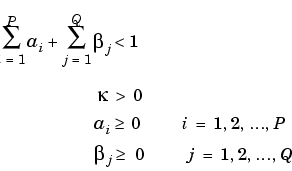

| Financial Toolbox |   |
Forecast conditional variance of univariate GARCH(P,Q) processes
Syntax
Arguments
Description
[VarianceForecast, H] = ugarchpred(U, Kappa, Alpha, Beta,
NumPeriods)
forecasts the conditional variance of univariate GARCH(P,Q) processes.
VarianceForecast is a number of periods (NUMPERIODS)-by-1 vector of the minimum mean-square error forecast of the conditional variance of the innovations time series vector U (i.e.,  t). The first element contains the 1-period-ahead forecast, the second element contains the 2-period-ahead forecast, and so on. Thus, if a forecast horizon greater than 1 is specified (
t). The first element contains the 1-period-ahead forecast, the second element contains the 2-period-ahead forecast, and so on. Thus, if a forecast horizon greater than 1 is specified (NUMPERIODS > 1), the forecasts of all intermediate horizons are returned as well. In this case, the last element contains the variance forecast of the specified horizon, NumPeriods from the most recent observation in U.
H is a vector of the conditional variances ( t2) corresponding to the innovations vector
t2) corresponding to the innovations vector U. It is inferred from the innovations U, and is a reconstruction of the "past" conditional variances, whereas the VarianceForecast output represents the projection of conditional variances into the "future." This sequence is based on setting pre-sample values of  t2 to the unconditional variance of the {
t2 to the unconditional variance of the { t} process.
t} process. H is a single column vector of the same length as the input innovations vector U.
The time-conditional variance,  t2, of a GARCH(P,Q) process is modeled as
t2, of a GARCH(P,Q) process is modeled as

where  represents the argument
represents the argument Alpha,  represents
represents Beta, and the GARCH(P,Q) coefficients { ,
,  ,
,  } are subject to the following constraints.
} are subject to the following constraints.

Note that U is a vector of residuals or innovations ( t) of an econometric model, representing a mean-zero, discrete-time stochastic process.
t) of an econometric model, representing a mean-zero, discrete-time stochastic process.
Although  t2 is generated using the equation above,
t2 is generated using the equation above,  t and
t and  t2 are related as
t2 are related as

where {vt} is an independent, identically distributed (i.i.d.) sequence ~ N(0,1).
Note
ugarchpred corresponds generally to the GARCH Toolbox function garchpred. The GARCH Toolbox provides a comprehensive and integrated computing environment for the analysis of volatility in time series. For information see the GARCH Toolbox User's Guide or the financial products Web page at http://www.mathworks.com/products/finprod/.
|
Examples
See ugarchsim for an example of forecasting the conditional variance of a univariate GARCH(P,Q) process.
See Also
ugarch, ugarchsim, and the GARCH Toolbox function garchpred
 | ugarchllf | ugarchsim |  |